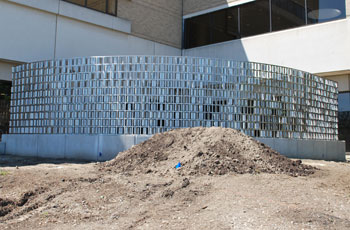New Sculpture Honors UM Transplant Team

Workers installing part of the "Rotations" sculpture on Friday outside the entrance to the UM Hospital. From left: Troco employees Brad Boulch, Tim Trotter, Tony Pacheco, sculptor Doug Hollis, and Troco employee Glen Steiner.
The sculpture by Doug Hollis outside the University of Michigan Hospital is a moving work of art. Literally.
Hollis – an Ann Arbor native and University of Michigan alumnus – described the piece as a “kinetic screen.” Located outside of the hospital’s main entrance, the sculpture is made entirely of stainless steel and contains rotating components that spin in the wind. Hollis explained that wind, water and motion are the main elements of his artistic vocabulary.
The university commissioned the sculpture, called “Rotations,” to honor the memory of the University of Michigan Medical Center transplant team who died when their plane crashed into Lake Michigan in June 2007.
Elaine Sims, director of UM’s Gifts of Art Program, explained in an email that Hollis was selected to create the sculpture by a task force of people from a variety of areas in the university, including the Transplant Department and Survival Flight. They sent out inquiries to organizations that had commissioned similar memorials, seeking guidance and names of sculptors. The task force requested qualifications from six artists and asked for proposals from two finalists out of that group before ultimately selecting Hollis, who now lives in San Francisco. Sims noted that they showed the final proposals to and asked for input from the families of the transplant team members who died in the crash. The entire process of selecting an artist took about one year.
The project cost $100,000, UM Health System Senior Public Relations Representative Margarita Bauza said. The university paid for it using health system funds and donations from the nonprofit community organization Friends (a partner of the health system).
The St. Louis-based construction company Troco started fabricating the sculpture about six weeks ago. They then transported its components to Ann Arbor and began installing it on May 14. A dedication ceremony is planned for June 3.
On Friday afternoon, The Chronicle dropped by as Hollis and several Troco workers were busy fitting the piece together. Hollis stood by a low concrete wall where wavy, perforated sheets of metal – the rotating parts of the sculpture – sat stacked in cardboard boxes.

Doug Hollis cleans what will become the rotating elements of the sculpture. The framework is being installed in the background.
“I thought it was quite a nice site,” Hollis said of his first impression of the location. The sculpture faces the hospital lobby’s windows on one side, the street leading up to the entrance on the other. “But I immediately thought I’d want to do something to screen the road.”
As of Friday afternoon, the sculpture consisted of the curving concrete wall, surrounded by dirt. Flat metal circles dotted the top of the wall. Hollis explained that they’d drilled 2-inch holes in the wall and put in anchor plates to hold up the screen element of his work. Everything would be welded together, he said.
One portion of the screen was already up close to the building. Hollis pointed out the sole rotator already in place in the large steel grid. In the next few days, they would install 599 more to fill the entire screen.
Hollis observed that the sculpture is also close to the helicopter pads, and the air currents created when the aircraft land or take off will set his art in motion. He said this seemed appropriate, given the sculpture’s link to the transplant team and the plane crash that claimed their lives.
As he spoke, the sound of a helicopter’s blades beating the air swelled around the installation site.
“You can feel the breeze,” Hollis remarked, smiling.
Sue Hadden, a University of Michigan registered nurse, stopped to investigate the burgeoning artwork.
“So far, I think it’s kind of cool,” Hadden said. “Visually, it’d be good. It can be very challenging to be an inpatient in the hospital and to have a diversion would be a good thing.”
When she learned why the sculpture was commissioned, she called it a “creative way to memorialize.”
Troco employee Glen Steiner said this is the third piece by Hollis that he’s helped construct during his time with the company. Steiner described Hollis’ work for the hospital as “pretty cool.”
“I’ll be excited to see a nice breeze come and make them all go around,” Steiner said of the spinning parts of the sculpture.
Steiner’s coworker Tony Pacheco, a metal polisher and grinder, said he liked how Hollis was devoting so much attention to his artwork’s installation.
“I think it’s great,” Pacheco said. “I can’t wait until it’s fully done so I can see it.”
Tim Trotter, head of Troco, who was on the site helping with the installation, called the sculpture “awesome.”
“Doug is just an outstanding artist,” Trotter said. “He understands the whole process really well, the fabricating.”
Trotter explained that the parts of the sculpture were cut and formed in his company’s shop in St. Louis according to Hollis’ design.
“We’re really honored to be a part of this,” Trotter said. “Not only to be working with Doug, but on the whole memorial piece and with the university.”
About the author: Helen Nevius, a student at Eastern Michigan University, is an intern with The Ann Arbor Chronicle.






I think it is too bad that an Ann Arbor artist was not chosen to memorialize these Ann Arborites.
Amanda, the artist is a UM alum, doesn’t that count for something?
Imagine if the selection committee for the Vietnam War Memorial had limited themselves to vets – we wouldn’t have Maya Lin’s moving work.
The artist was born in Ann Arbour in 1948